827
This danger at sea few know
Many people thrive in water, do not understand how it is possible to sink near the sea or ocean shore. The majority believes that in such cases the blame drunkenness, but sometimes it is quite a different phenomenon - rip current.
In this article Website will tell you what it is and how to avoid the fate of those who do not know what to do in such a dangerous situation.
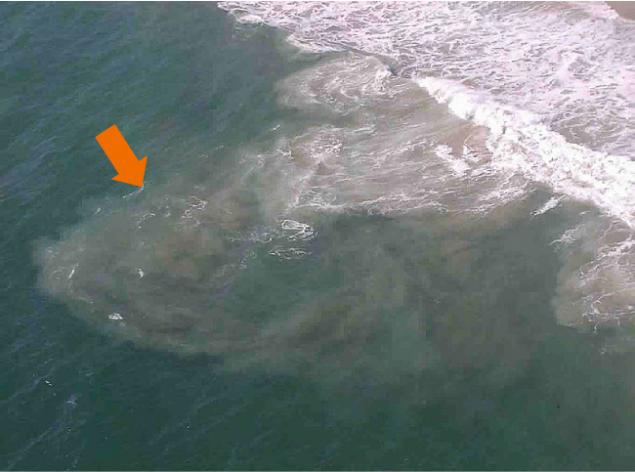
Rip current, or as it is called by foreigners, rip current (rip) - one of the most dangerous phenomena. Here are some of these trends and how ordinary people are drowning, and first-class swimmers, because they simply do not know how to behave.
Are you trying to resist the stream to swim, but nothing happens. A couple of moments, and the panic begins ...
The most dangerous for people rip current shallow seas with a flat, low-lying coast, which is framed by sand bars, shoals and islets (the Gulf of Mexico, the Sea of Azov, and others.). In this case, when the tide is the mass of water can not gradually get back into the open sea because of the restraining their spit. The water pressure in the narrow strait that connects the estuary with the sea, increases sharply. At this point rapids formed by which water rushes back into the sea at high speed (up to 2, 5-3, 0 m / s), forming as it were a river in the midst of the sea.
This is how it looks schematically
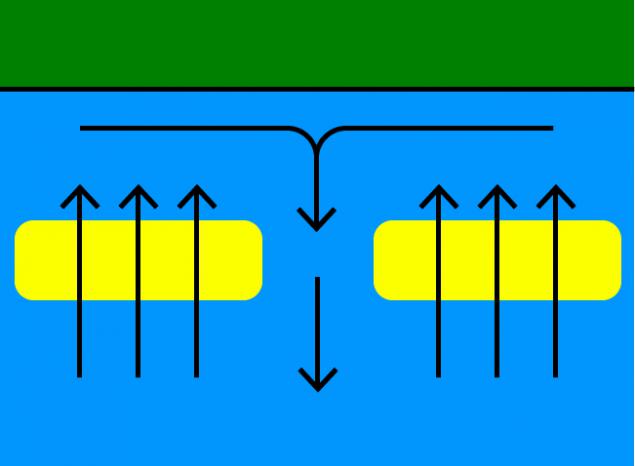
These corridors occur in any places Beach , near the shore during high tide. The waves, one after the other rolls and bring more and more water, then different rates go back to the sea or the ocean, forming a reverse flow.
It looks like a river:
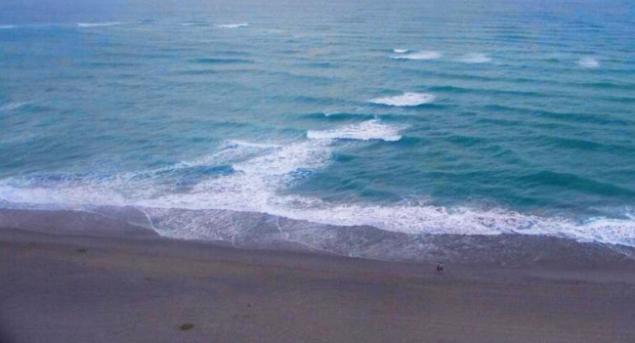

In this picture is not so pronounced swirling streams of water, but it can be clearly seen for itself and, unfortunately, people who have got into it:

Typically, a narrow corridor rip: 2-3 meters at a speed of 4-5 km / h. This is not dangerous. However, there may be rip current width of 50 meters and a length of 200-400 meters, at speeds up to 15 km / h! Rips a length of infrequent, but still there.
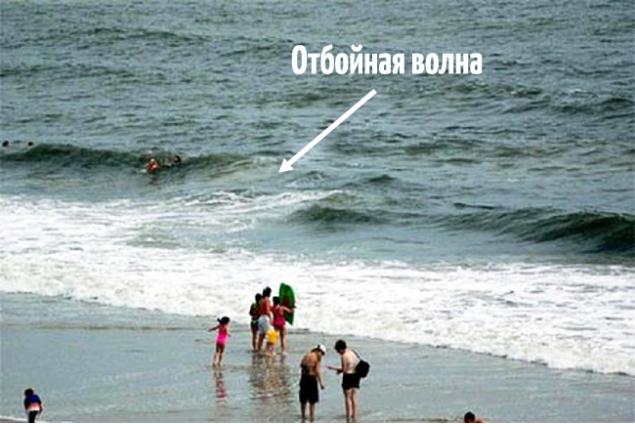
How do we determine it is for that not to get into it? Pay attention to the following markings
Visible channel boiling water perpendicular to the shore. The coastal area of discolored water (say, all around the blue or green, but some portion of the white). Plot foam, some marine vegetation, bubbles, which is steadily moving from the coast to the open sea. The gap in the overall structure of tidal waves (continuous-wave band, and in the middle of 5-10 meter gap). < /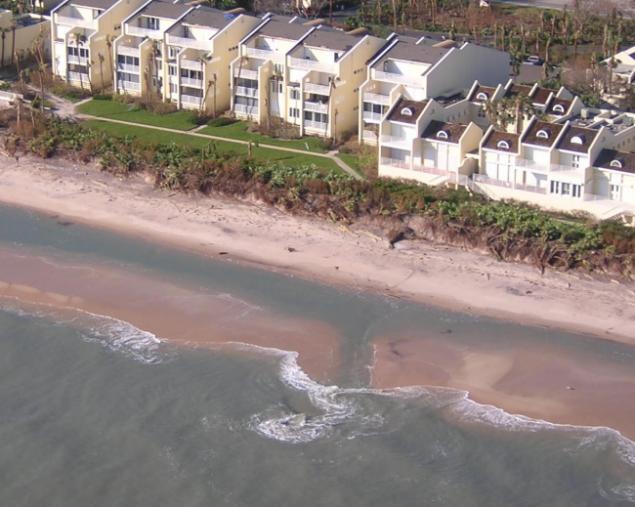
If you see something out of the described, consider yourself lucky and just do not go to swim in this place. And what if you do not see any signs of 4? So you're out of luck, because 80% of spontaneously occurring dangerous rips did not manifest itself visually
rip current near the shore there. That is, even if you are standing in water up to his waist, and especially on the chest, you can pick up and carry to rip into the sea. But just those who can not swim and do - just stand in the water and enjoy.
Therefore, do not swim alone and, of course, do not ignore the red flags and signs on the beach.
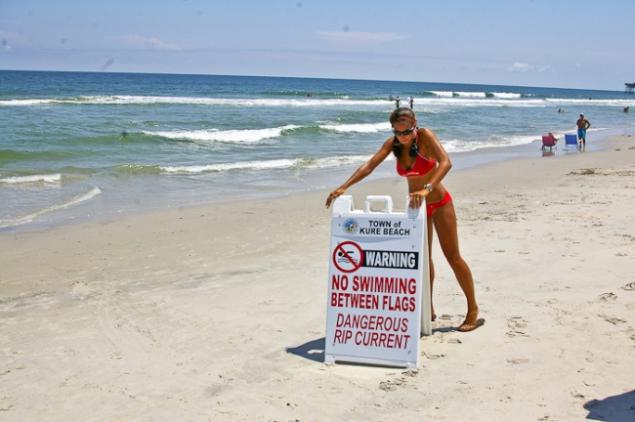
Rules of conduct in the rip current:
Do not panic! to panic, we are guided by an instinct of self-preservation, and do not rely on sound reasoning. Knowing how to behave in ripping you in 100 cases out of 100 will be selected.
Save power! Do not fight over and Row back to shore. Unfortunately, it's useless. Rowing is necessary not to the bank, and to the side (ie parallel to the shore). If you rip a narrow (up to 5 meters), you get out of it quickly.
If rip wide (20 meters and more), what to do? You can not so easy to get out of it, even if you pull on the rules - the side. As soon as you realize that you did not get to go out, you can relax, but do not panic! The fact that the reverse for a short time, and already after 5 minutes, it will stop and leave you alone. Then sail 50-100 meters towards the first, and only then to the beach. If you just sail to the shore, there is a possibility that the flow will resume at the same place and you'll get it.
It is important to consider the following: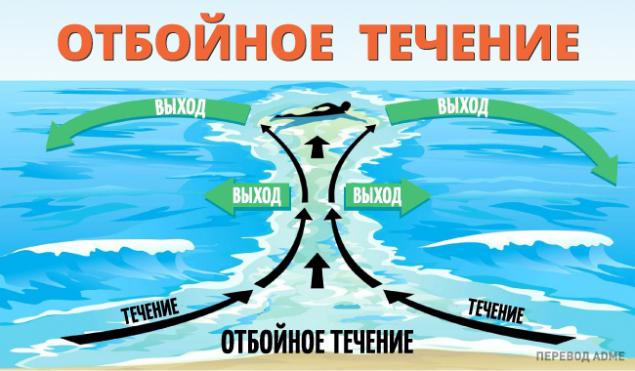
Rip never carry off you at the bottom. It's not a whirlpool or vortex. All the rip current in the world being dragged from the coast along the surface, but not in depth!
Rip it is not too wide. Typically, the width does not exceed 50 meters. And often limited to only 10-20 meters. That is, swim along the shore just 20-30 meters, you will feel that emerged from the rip.
The length of the rip is limited. for quite rapidly weaken, the channel ends his "job" where the waves reach their peak and begin to break. In the language of the place surfer called "line up» (line up). At this point, all the surfers usually hang out and try to ride the wave coming. Usually it is not more than 100 meters from the shore.
Please tell your friends about this phenomenon. let more people know about the rip current. Thus you will save not only their lives, but also other people.
Author: Anna Romanova
via annaromanova.ru/
In this article Website will tell you what it is and how to avoid the fate of those who do not know what to do in such a dangerous situation.

Rip current, or as it is called by foreigners, rip current (rip) - one of the most dangerous phenomena. Here are some of these trends and how ordinary people are drowning, and first-class swimmers, because they simply do not know how to behave.
Are you trying to resist the stream to swim, but nothing happens. A couple of moments, and the panic begins ...
The most dangerous for people rip current shallow seas with a flat, low-lying coast, which is framed by sand bars, shoals and islets (the Gulf of Mexico, the Sea of Azov, and others.). In this case, when the tide is the mass of water can not gradually get back into the open sea because of the restraining their spit. The water pressure in the narrow strait that connects the estuary with the sea, increases sharply. At this point rapids formed by which water rushes back into the sea at high speed (up to 2, 5-3, 0 m / s), forming as it were a river in the midst of the sea.
This is how it looks schematically

These corridors occur in any places Beach , near the shore during high tide. The waves, one after the other rolls and bring more and more water, then different rates go back to the sea or the ocean, forming a reverse flow.
It looks like a river:


In this picture is not so pronounced swirling streams of water, but it can be clearly seen for itself and, unfortunately, people who have got into it:

Typically, a narrow corridor rip: 2-3 meters at a speed of 4-5 km / h. This is not dangerous. However, there may be rip current width of 50 meters and a length of 200-400 meters, at speeds up to 15 km / h! Rips a length of infrequent, but still there.

How do we determine it is for that not to get into it? Pay attention to the following markings
Visible channel boiling water perpendicular to the shore. The coastal area of discolored water (say, all around the blue or green, but some portion of the white). Plot foam, some marine vegetation, bubbles, which is steadily moving from the coast to the open sea. The gap in the overall structure of tidal waves (continuous-wave band, and in the middle of 5-10 meter gap). < /

If you see something out of the described, consider yourself lucky and just do not go to swim in this place. And what if you do not see any signs of 4? So you're out of luck, because 80% of spontaneously occurring dangerous rips did not manifest itself visually
rip current near the shore there. That is, even if you are standing in water up to his waist, and especially on the chest, you can pick up and carry to rip into the sea. But just those who can not swim and do - just stand in the water and enjoy.
Therefore, do not swim alone and, of course, do not ignore the red flags and signs on the beach.

Rules of conduct in the rip current:

Do not panic! to panic, we are guided by an instinct of self-preservation, and do not rely on sound reasoning. Knowing how to behave in ripping you in 100 cases out of 100 will be selected.
Save power! Do not fight over and Row back to shore. Unfortunately, it's useless. Rowing is necessary not to the bank, and to the side (ie parallel to the shore). If you rip a narrow (up to 5 meters), you get out of it quickly.
If rip wide (20 meters and more), what to do? You can not so easy to get out of it, even if you pull on the rules - the side. As soon as you realize that you did not get to go out, you can relax, but do not panic! The fact that the reverse for a short time, and already after 5 minutes, it will stop and leave you alone. Then sail 50-100 meters towards the first, and only then to the beach. If you just sail to the shore, there is a possibility that the flow will resume at the same place and you'll get it.
It is important to consider the following:

Rip never carry off you at the bottom. It's not a whirlpool or vortex. All the rip current in the world being dragged from the coast along the surface, but not in depth!
Rip it is not too wide. Typically, the width does not exceed 50 meters. And often limited to only 10-20 meters. That is, swim along the shore just 20-30 meters, you will feel that emerged from the rip.
The length of the rip is limited. for quite rapidly weaken, the channel ends his "job" where the waves reach their peak and begin to break. In the language of the place surfer called "line up» (line up). At this point, all the surfers usually hang out and try to ride the wave coming. Usually it is not more than 100 meters from the shore.
Please tell your friends about this phenomenon. let more people know about the rip current. Thus you will save not only their lives, but also other people.
Author: Anna Romanova
via annaromanova.ru/
I saw the ravens ate in the park, and was stunned by what she did then
"You can not be her first ..."























